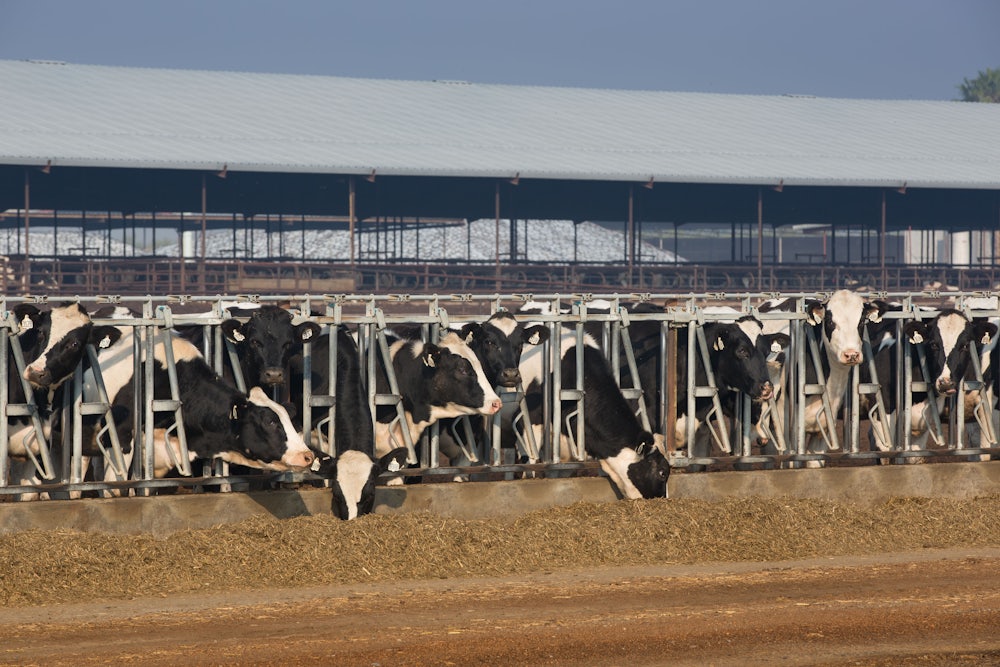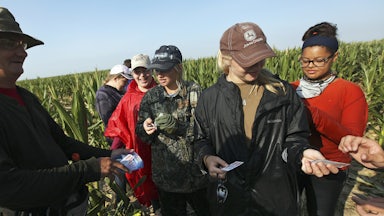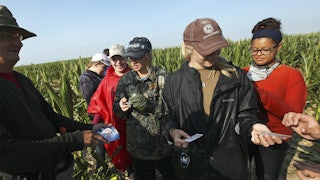Almost everyone’s eager to finally claim a win on climate policy and move on: After over a year of negotiations and derailing the Democrats’ climate agenda multiple times, renowned fossil fuel booster Joe Manchin has finally thrown his support behind $370 billion worth of subsidies and rebates for renewable and efficient energy, including solar panels, heat pumps, and electric vehicles. All of these technologies included in the rebranded Inflation Reduction Act have strong and proven potential to reduce greenhouse gas emissions. While it’s not nearly enough to get us to zero emissions—most worryingly, it does not immediately curtail fossil fuel extraction—it’s a leap in the right direction, in that it should help renewable energy outcompete fossil fuels.
But there’s another set of provisions in this bill that is far murkier: tens of billions of dollars in “climate-smart” agriculture investments. The incentives this money will be used for are a mixed and confusing bag. Some of these investments are good. Some, however, are of uncertain value, and some are downright bad—supporting initiatives that could actually lead to more land clearing, fertilizer use, and intensive animal breeding, all of which may create more emissions rather than less.
Agriculture contributes about a quarter of the world’s climate-changing greenhouse gas emissions. Add to that amount all the emissions from the entire food system—clearing land, producing fertilizer, shipping food around the world, and letting our food waste rot in landfills—and that total jumps to one-third. Of that total, animal agriculture contributes the majority of emissions. In the U.S., agriculture only accounts for about a tenth of total emissions. Is this because our agriculture is clean and sustainable? Not quite. Other U.S. emissions, from sources like power plants and construction and automobiles, are so high that it makes the relative contribution of agriculture seem small. And while we produce crops more efficiently than many other countries, we produce a lot of them, so our per-capita emissions from agriculture are extremely high, beaten out only by Australia’s and those of a few other affluent countries.
The basic takeaway from this is that if we could only make emissions cuts to one sector of the U.S. economy, it should be energy generation, but to meet our climate reduction targets, we actually need to reduce emissions in almost every sector drastically, including those from agriculture and food.
This is where the current climate bill mostly seems to fall short, doubling down on existing practices that don’t necessarily help reduce emissions. The worst offender in the IRA is a host of credits and incentives for biofuels. These fuels are made from edible crops such as corn and soy, which compete with our food supply and increase the demand on our land, leading to clearing and tillage. Most of the language in the bill is geared toward “advanced biofuels” that use by-products and nonedible crops (like sawdust, wheat straws, algae, or switchgrass), but those advanced fuels have repeatedly failed to materialize. As a result, our fertilizer- and land-hungry systems of corn ethanol production have generated more greenhouse gas emissions than they have saved.
This is indicative of what seems to be the bill’s approach to agriculture: shunting money to existing programs and to the Department of Agriculture. The largest pot of agriculture money allocated by the IRA—$20 billion—is being left to the USDA to spend as it sees fit on efforts that reduce greenhouse gases or “sequester” them on farmlands, mostly through existing voluntary programs like the Conservation Stewardship Program and the Environmental Quality Incentives Program. These programs provide financial and technical assistance to farmers and ranchers to engage in various conservation initiatives on their land, such as using cover crops, reducing water contamination, and protecting pollinators and native plants. While some studies have shown that these programs can have beneficial effects, including on soil health, their uptake is spotty and there is inconsistent evidence that they generate good taxpayer value for conservation outcomes.
But when it comes to specifics of how this funding will actually achieve climate goals, the IRA is short on details. For instance, the IRA funds farmers for soil carbon sequestration, which is a fancy name for the as-yet rather theoretical and dubious capacity of farmlands to pull down significant levels of climate-warming carbon dioxide out of the air and into the soil. Far from a sure thing, keeping carbon locked into soils and out of the atmosphere is a complex and still imperfectly understood practice. It depends on a whole host of factors that the world’s top scientists are still trying to figure out, including the precise timing of rainfall, the texture of the soil, the frequency of grazing animals, and the exact planting dates of crops.
There’s also the problem that most of America’s farmland is used for animal agriculture. Remember those national and global totals of greenhouse gas emissions? The majority of them come from farmed animals and all the feed and resources they require. Livestock also uses far more land than all of the plants that we humans eat or could possibly eat. But rather than tackling the cow in the room head-on, the draft legislation tinkers at the edges, devoting potentially billions of dollars to initiatives like feeding cattle ingredients such as seaweeds and synthetic chemicals that aim to reduce the methane from their belches. Despite the hype, these feeds only mitigate a small fraction of cattle’s methane emissions and, if they were to be subsidized by the government and sourced at scale, could create a slew of sustainability issues of their own.
If anything, the bill’s massive injection of cash into America’s beef sector could lead to unintended consequences: more cattle, lower beef prices, and thus even higher emissions than before, all masked by the promise that mass-scale animal agriculture can be sustainable with a few tweaks like feeding livestock seaweed.
More broadly, focusing on soil carbon sequestration could reduce yields in some cases. Without changing demand for products like corn ethanol and beef, smaller yields would lead to even more land demand. For example, exclusively grass-fed beef has shown some potential to sequester carbon but requires multiple times more land than conventionally raised beef produced in feedlots. Scaling up lower-yielding methods for the sake of soil carbon would spur farmers to clear and plow up the lands that actually sequester carbon: native ecosystems.
Natural ecosystems, as well as Indigenous management, are likely our best bet for pulling atmospheric carbon back into soils and vegetation. By comparison, the amount of carbon that we could theoretically sequester back into agricultural soils is relatively small—less than 10 percent of what could be sequestered in wild landscapes according to recent research. Agricultural carbon sequestration could still be worth pursuing, but it is precarious and may be reversed by even slight levels of warming and shorter winters, which increases soil respiration.
The IRA’s agricultural spending isn’t all bad: It earmarks $1.5 billion for more agricultural research, and specifically for conservation. This is great because of how much we still need to know about reducing erosion, fertilizer and manure runoff that causes water pollution, and greenhouse gas emissions to slow climate change. Research can help fill in these crucial knowledge gaps, as well as fostering better technologies like sensors, robotics, and even satellite images to help farmers apply fewer chemicals and help keep more nutrients in the soils and plants. In fact, what we need first and foremost—and before we commit to expensive soil carbon sequestration projects—is funding and support for basic research on how, where, and why soil carbon sequestration works on agricultural lands. We also need to know more about the benefits and limitations of mitigating emissions from cattle ranches.
Of course, the deeper problems with American agriculture, which need to be addressed if we’re ever to make major progress reducing emissions, are bigger than a single bill like the IRA can solve. Moving forward, the USDA needs to be more open to policies and research that do not support its existing programs, favored conclusions, or the interests of the producers it represents.
The USDA is hamstrung by its foundational conflict of interest: It is both the regulator of the U.S. agriculture industry and its promoter and marketer. Current and past administrations have focused on finding new payouts for farmers through new carbon trading schemes and earmarked funds. But research may well show that paying ranchers and farmers for activities that could mitigate emissions, on top of the billions in subsidies they already receive, does not actually lead to better climate or environmental outcomes.
Meanwhile, despite significant incentives in the IRA for climate-smart choices in other areas like home heating and power generation, there is nothing in the bill about incentivizing the sorts of changes to food production and demand that we know could significantly reduce emissions. Examples of truly climate-smart food system investments would include measures like setting aside more low-production farmlands for wildlife conservation, nudging consumers toward a plant-forward diet, and fixing deceptive expiration date labels on foods that stores and consumers throw out for absolutely no reason. Americans eat more than 200 pounds of meat per year and discard one-third of our perfectly edible food. Reducing this waste and overconsumption could free up far more land for regrowing intact and resilient life-supporting ecosystems that also sequester carbon, and reduced demand for meat would reduce meat production emissions.
Currently, countries like Germany are changing their food habits to reduce their personal meat consumption gradually but significantly. They are also supporting candidates who adopt meat reduction in their political platforms, along with sustainable and just transitions for their agricultural producers. The Netherlands and Israel, among other countries, are investing in federal research on the development and commercialization of lower-emissions plant- and cell-based meat alternatives. There is also a strong case to be made for diversifying and promoting traditional sources of protein like beans. (Bean New Deal anyone?)
Reducing agriculture’s climate impact requires initiatives like these that actually change what we produce and eat and think. We need to overcome the entrenched interests of the status quo to reverse the deep politicization of our food choices and farming that have blocked progress for generations. American farm owners and corporations are mainly business owners looking to maximize profit; the vast majority of them bear no resemblance to the downtrodden and impoverished peasants of past centuries. As in any other business, we need a sensible combination of sticks and carrots to reward good behavior and punish bad behavior like pollution and price fixing. Right now, it’s all rewards with little effective regulation. The bill currently on the table does little to change that.










